2015 FIAT GRANDE PUNTO ACTUAL boot
[x] Cancel search: bootPage 170 of 216
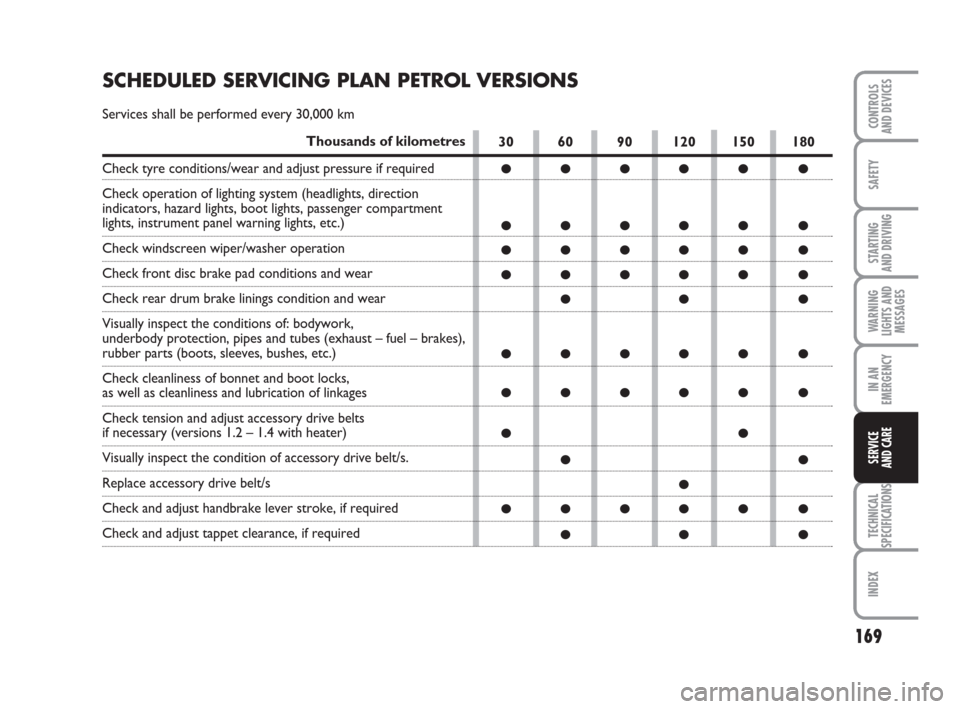
169
SAFETY
STARTING
AND DRIVING
WARNING
LIGHTS AND
MESSAGES
IN AN
EMERGENCY
TECHNICAL
SPECIFICATIONS
INDEX
CONTROLS
AND DEVICES
SERVICE
AND CARE
30 60 90 120 150 180
●●●●● ●
●●●●● ●
●●●●● ●
●●●●● ●
●● ●
●●●●● ●
●●●●● ●
●●
●●
●
●●●●● ●
●● ●
SCHEDULED SERVICING PLAN PETROL VERSIONS
Services shall be performed every 30,000 km
Thousands of kilometres
Check tyre conditions/wear and adjust pressure if required
Check operation of lighting system (headlights, direction
indicators, hazard lights, boot lights, passenger compartment
lights, instrument panel warning lights, etc.)
Check windscreen wiper/washer operation
Check front disc brake pad conditions and wear
Check rear drum brake linings condition and wear
Visually inspect the conditions of: bodywork,
underbody protection, pipes and tubes (exhaust – fuel – brakes),
rubber parts (boots, sleeves, bushes, etc.)
Check cleanliness of bonnet and boot locks,
as well as cleanliness and lubrication of linkages
Check tension and adjust accessory drive belts
if necessary (versions 1.2 – 1.4 with heater)
Visually inspect the condition of accessory drive belt/s.
Replace accessory drive belt/s
Check and adjust handbrake lever stroke, if required
Check and adjust tappet clearance, if required
167-186 ACTUAL 1ed EN 27-07-2010 10:30 Pagina 169
Page 172 of 216
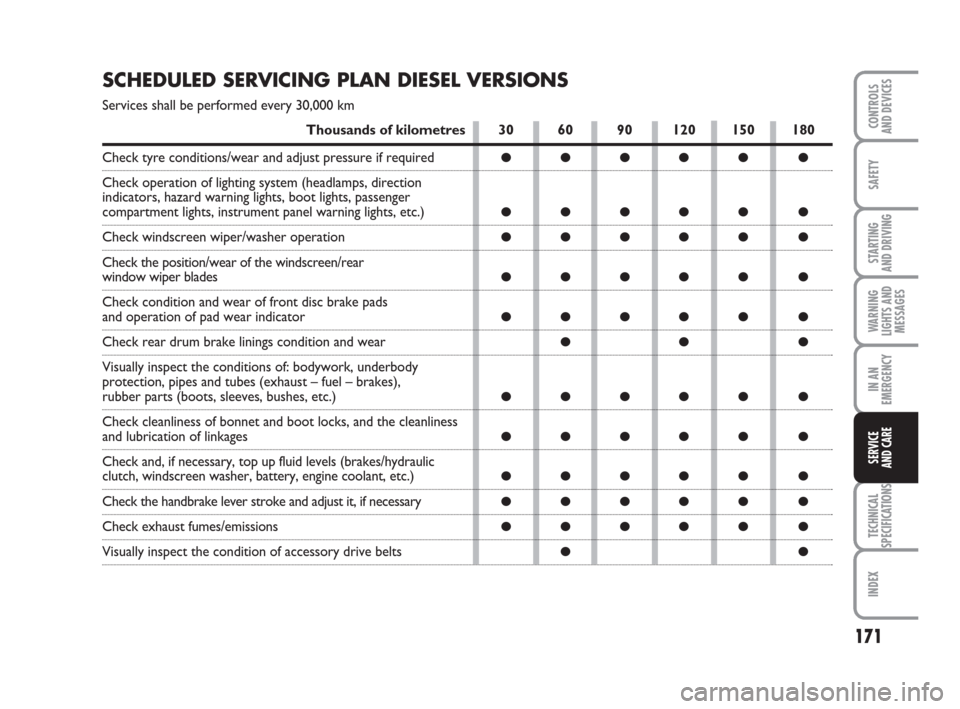
171
SAFETY
STARTING
AND DRIVING
WARNING
LIGHTS AND
MESSAGES
IN AN
EMERGENCY
TECHNICAL
SPECIFICATIONS
INDEX
CONTROLS
AND DEVICES
SERVICE
AND CARE
SCHEDULED SERVICING PLAN DIESEL VERSIONS
Services shall be performed every 30,000 km
30 60 90 120 150 180
●●●●● ●
●●●●● ●
●●●●● ●
●●●●● ●
●●●●● ●
●● ●
●●●●● ●
●●●●● ●
●●●●● ●
●●●●● ●
●●●●● ●
●●
Thousands of kilometres
Check tyre conditions/wear and adjust pressure if required
Check operation of lighting system (headlamps, direction
indicators, hazard warning lights, boot lights, passenger
compartment lights, instrument panel warning lights, etc.)
Check windscreen wiper/washer operation
Check the position/wear of the windscreen/rear
window wiper blades
Check condition and wear of front disc brake pads
and operation of pad wear indicator
Check rear drum brake linings condition and wear
Visually inspect the conditions of: bodywork, underbody
protection, pipes and tubes (exhaust – fuel – brakes),
rubber parts (boots, sleeves, bushes, etc.)
Check cleanliness of bonnet and boot locks, and the cleanliness
and lubrication of linkages
Check and, if necessary, top up fluid levels (brakes/hydraulic
clutch, windscreen washer, battery, engine coolant, etc.)
Check the handbrake lever stroke and adjust it, if necessary
Check exhaust fumes/emissions
Visually inspect the condition of accessory drive belts
167-186 ACTUAL 1ed EN 27-07-2010 10:30 Pagina 171
Page 174 of 216

173
SAFETY
STARTING
AND DRIVING
WARNING
LIGHTS AND
MESSAGES
IN AN
EMERGENCY
TECHNICAL
SPECIFICATIONS
INDEX
CONTROLS
AND DEVICES
SERVICE
AND CARE
DEMANDING USE
OF THE CAR
Should the car be used predominantly in
one of the following particularly demand-
ing conditions:
❒trailer or caravan towing;
❒dusty roads;
❒short (less than 7-8 km) and repeated
journeys in sub-zero temperatures;
❒ frequently idling engine or long-dis-
tance, low-speed driving (e.g. door-to-
door deliveries) or lengthy inactivity;
❒ driving in towns and cities;
you should perform the following inspec-
tions more frequently than shown on the
Scheduled Servicing Plan:
❒ check front disc brake pad conditions
and wear;
❒check cleanliness of bonnet and boot
locks, and cleanliness and lubrication of
linkages;
❒ visually inspect the conditions of: en-
gine, gearbox, transmission, pipes and
tubes (exhaust – fuel – brakes), rubber
parts (boots, sleeves, bushes, etc.);
❒check battery charge and liquid level
(electrolyte);
❒visually inspect the condition of the ac-
cessory drive belts;
❒check pollen filter and replace, if re-
quired;
❒check air filter and replace, if required.
REGULAR CHECKS
Every 1,000 km or before long journeys,
check and, if necessary, top up:
❒engine coolant fluid level;
❒brake fluid level;
❒windscreen washer level;
❒tyre pressure and conditions.
❒operation of lights (headlights, direction
indicators, hazard lights, etc.);
❒operation of the windscreen wiper/
washer system, position and wear of
the windscreen and rear window wiper
blades;
Every 3,000 km, check and top up, if re-
quired, the engine oil level.
You are recommended to use PETRONAS
LUBRICANTS products, which have been
designed and produced specifically for
Fiat cars (see table “Capacities” in the
“Technical specifications” section).
167-186 ACTUAL 1ed EN 27-07-2010 10:30 Pagina 173
Page 181 of 216
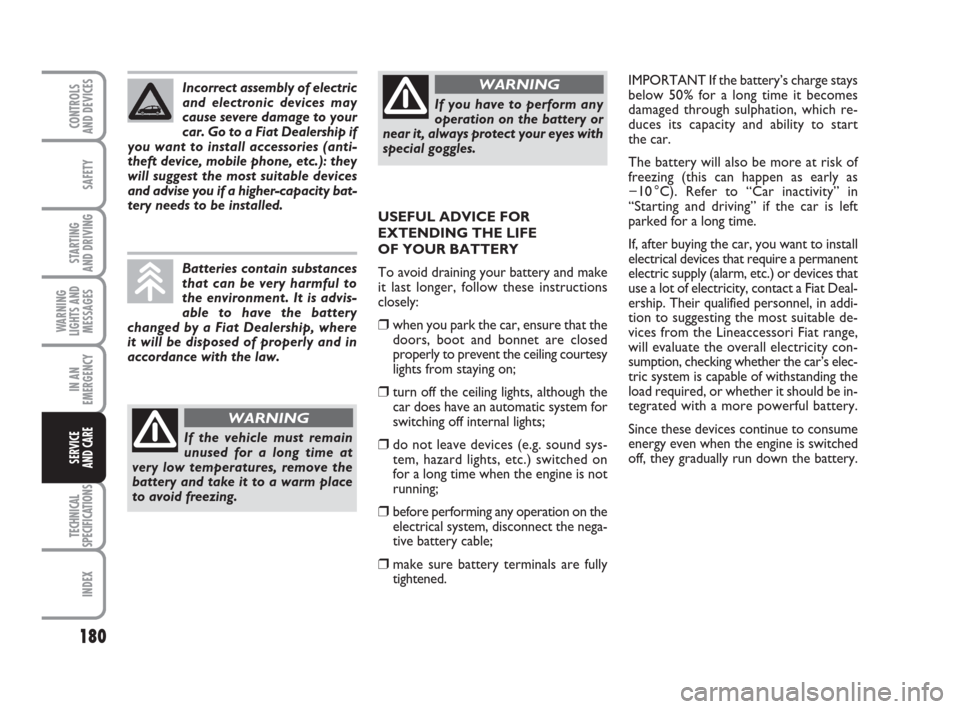
180
SAFETY
STARTING
AND DRIVING
WARNING
LIGHTS AND
MESSAGES
IN AN
EMERGENCY
TECHNICAL
SPECIFICATIONS
INDEX
CONTROLS
AND DEVICES
SERVICE
AND CARE
IMPORTANT If the battery’s charge stays
below 50% for a long time it becomes
damaged through sulphation, which re-
duces its capacity and ability to start
the car.
The battery will also be more at risk of
freezing (this can happen as early as
−10 °C). Refer to “Car inactivity” in
“Starting and driving” if the car is left
parked for a long time.
If, after buying the car, you want to install
electrical devices that require a permanent
electric supply (alarm, etc.) or devices that
use a lot of electricity, contact a Fiat Deal-
ership. Their qualified personnel, in addi-
tion to suggesting the most suitable de-
vices from the Lineaccessori Fiat range,
will evaluate the overall electricity con-
sumption, checking whether the car’s elec-
tric system is capable of withstanding the
load required, or whether it should be in-
tegrated with a more powerful battery.
Since these devices continue to consume
energy even when the engine is switched
off, they gradually run down the battery. USEFUL ADVICE FOR
EXTENDING THE LIFE
OF YOUR BATTERY
To avoid draining your battery and make
it last longer, follow these instructions
closely:
❒when you park the car, ensure that the
doors, boot and bonnet are closed
properly to prevent the ceiling courtesy
lights from staying on;
❒turn off the ceiling lights, although the
car does have an automatic system for
switching off internal lights;
❒do not leave devices (e.g. sound sys-
tem, hazard lights, etc.) switched on
for a long time when the engine is not
running;
❒before performing any operation on the
electrical system, disconnect the nega-
tive battery cable;
❒make sure battery terminals are fully
tightened. Incorrect assembly of electric
and electronic devices may
cause severe damage to your
car. Go to a Fiat Dealership if
you want to install accessories (anti-
theft device, mobile phone, etc.): they
will suggest the most suitable devices
and advise you if a higher-capacity bat-
tery needs to be installed.
Batteries contain substances
that can be very harmful to
the environment. It is advis-
able to have the battery
changed by a Fiat Dealership, where
it will be disposed of properly and in
accordance with the law.
If the vehicle must remain
unused for a long time at
very low temperatures, remove the
battery and take it to a warm place
to avoid freezing.
WARNING
If you have to perform any
operation on the battery or
near it, always protect your eyes with
special goggles.
WARNING
167-186 ACTUAL 1ed EN 27-07-2010 10:30 Pagina 180
Page 189 of 216
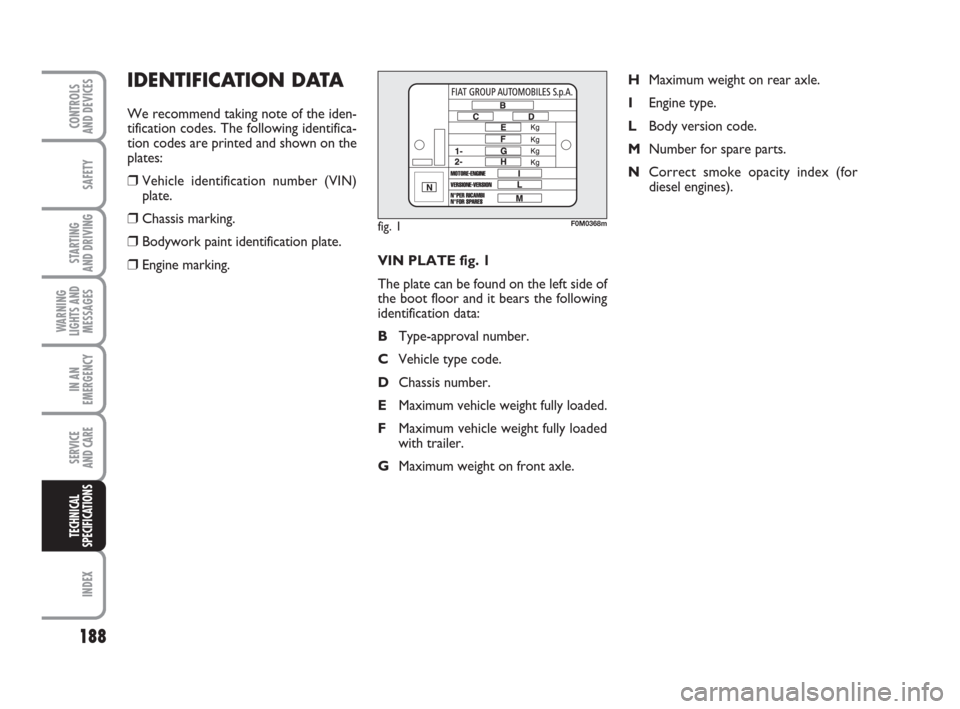
188
SAFETY
STARTING
AND DRIVING
WARNING
LIGHTS AND
MESSAGES
IN AN
EMERGENCY
SERVICE
AND CARE
INDEX
CONTROLS
AND DEVICES
TECHNICAL
SPECIFICATIONS
VIN PLATE fig. 1
The plate can be found on the left side of
the boot floor and it bears the following
identification data:
BType-approval number.
CVehicle type code.
DChassis number.
EMaximum vehicle weight fully loaded.
FMaximum vehicle weight fully loaded
with trailer.
GMaximum weight on front axle.HMaximum weight on rear axle.
IEngine type.
LBody version code.
MNumber for spare parts.
NCorrect smoke opacity index (for
diesel engines).
IDENTIFICATION DATA
We recommend taking note of the iden-
tification codes. The following identifica-
tion codes are printed and shown on the
plates:
❒Vehicle identification number (VIN)
plate.
❒Chassis marking.
❒Bodywork paint identification plate.
❒Engine marking.
fig. 1F0M0368m
187-204 ACTUAL 1ed EN 26-07-2010 16:08 Pagina 188
Page 199 of 216

198
SAFETY
STARTING
AND DRIVING
WARNING
LIGHTS AND
MESSAGES
IN AN
EMERGENCY
SERVICE
AND CARE
INDEX
CONTROLS
AND DEVICES
TECHNICAL
SPECIFICATIONS
DIMENSIONS
Dimensions are expressed in mm and re-
fer to the vehicle fitted with its original
tyres.
Height is measured with the vehicle un-
laden.
Boot capacity
Capacity with vehicle unladen
(VDA standards): ........................ 275 dm
3
Capacity with rear seat and
backrest folded over: .................1030 dm3
F0M0369m
fig. 6
Version A B C D E F G H3 - 5 doors
1.2 - 1.4
1.3 Multijet4030 875 2510 645 1490 1473 1687 146
IMPORTANT Measurements may vary according to rim/tyre size.
187-204 ACTUAL 1ed EN 26-07-2010 16:08 Pagina 198
Page 200 of 216
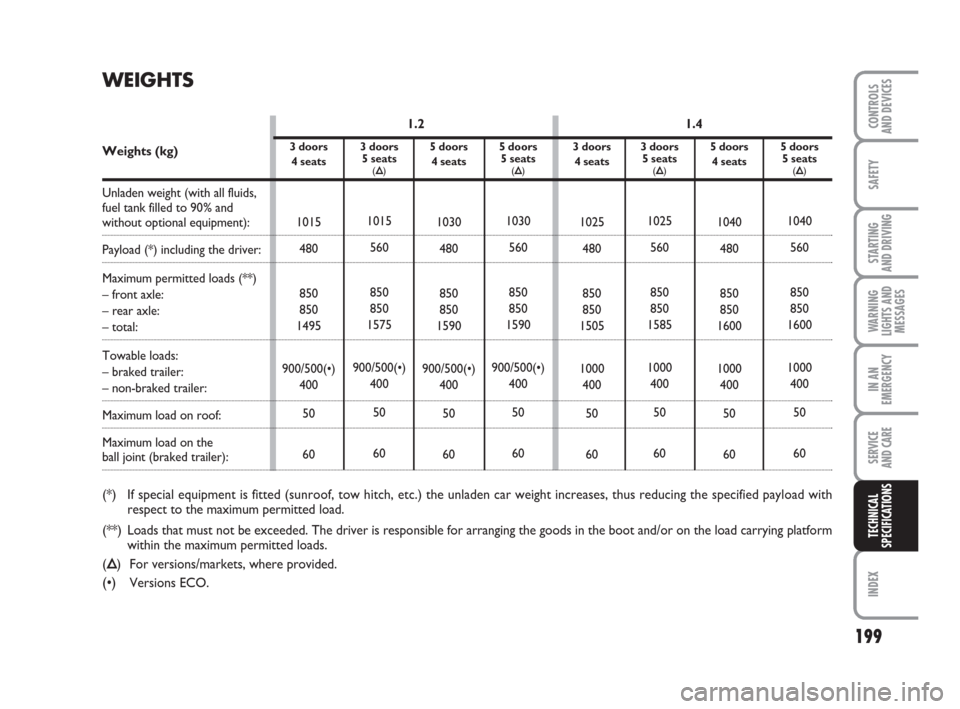
5 doors
4 seats
1030
480
850
850
1590
900/500(•)
400
50
60
5 doors
5 seats
(Õ)
1030
560
850
850
1590
900/500(•)
400
50
60
3 doors
4 seats
1025
480
850
850
1505
1000
400
50
60
3 doors
5 seats
(Õ)
1025
560
850
850
1585
1000
400
50
60
5 doors
4 seats
1040
480
850
850
1600
1000
400
50
60
5 doors
5 seats
(Õ)
1040
560
850
850
1600
1000
400
50
60
3 doors
4 seats
1015
480
850
850
1495
900/500(•)
400
50
60
3 doors
5 seats
(Õ)
1015
560
850
850
1575
900/500(•)
400
50
60
199
SAFETY
STARTING
AND DRIVING
WARNING
LIGHTS AND
MESSAGES
IN AN
EMERGENCY
SERVICE
AND CARE
INDEX
CONTROLS
AND DEVICES
TECHNICAL
SPECIFICATIONS
WEIGHTS
1.2 1.4
Weights (kg)
Unladen weight (with all fluids,
fuel tank filled to 90% and
without optional equipment):
Payload (*) including the driver:
Maximum permitted loads (**)
– front axle:
– rear axle:
– total:
Towable loads:
– braked trailer:
– non-braked trailer:
Maximum load on roof:
Maximum load on the
ball joint (braked trailer):
(*) If special equipment is fitted (sunroof, tow hitch, etc.) the unladen car weight increases, thus reducing the specified payload with
respect to the maximum permitted load.
(**) Loads that must not be exceeded. The driver is responsible for arranging the goods in the boot and/or on the load carrying platform
within the maximum permitted loads.
(Õ) For versions/markets, where provided.
(•)Versions ECO.
187-204 ACTUAL 1ed EN 26-07-2010 16:08 Pagina 199
Page 201 of 216
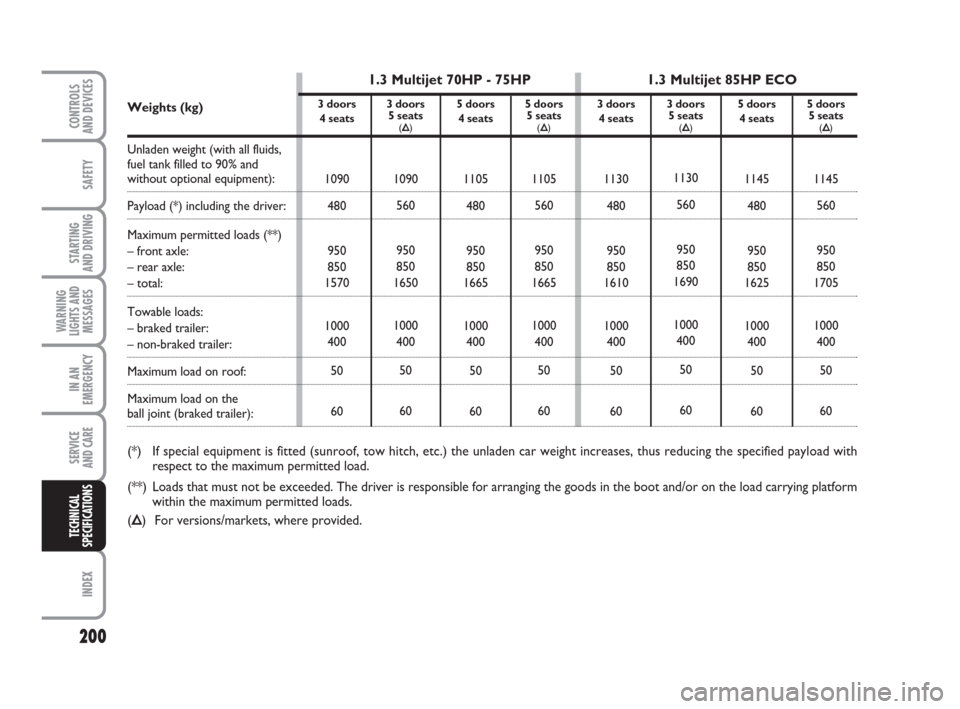
200
SAFETY
STARTING
AND DRIVING
WARNING
LIGHTS AND
MESSAGES
IN AN
EMERGENCY
SERVICE
AND CARE
INDEX
CONTROLS
AND DEVICES
TECHNICAL
SPECIFICATIONS
3 doors
4 seats
1090
480
950
850
1570
1000
400
50
60
3 doors
5 seats
(Õ)
1090
560
950
850
1650
1000
400
50
60
5 doors
4 seats
1105
480
950
850
1665
1000
400
50
60
5 doors
5 seats
(Õ)
1105
560
950
850
1665
1000
400
50
60
3 doors
4 seats
1130
480
950
850
1610
1000
400
50
60
3 doors
5 seats
(Õ)
1130
560
950
850
1690
1000
400
50
60
5 doors
4 seats
1145
480
950
850
1625
1000
400
50
60
5 doors
5 seats
(Õ)
1145
560
950
850
1705
1000
400
50
60
1.3 Multijet 70HP - 75HP 1.3 Multijet 85HP ECO
Weights (kg)
Unladen weight (with all fluids,
fuel tank filled to 90% and
without optional equipment):
Payload (*) including the driver:
Maximum permitted loads (**)
– front axle:
– rear axle:
– total:
Towable loads:
– braked trailer:
– non-braked trailer:
Maximum load on roof:
Maximum load on the
ball joint (braked trailer):
(*) If special equipment is fitted (sunroof, tow hitch, etc.) the unladen car weight increases, thus reducing the specified payload with
respect to the maximum permitted load.
(**) Loads that must not be exceeded. The driver is responsible for arranging the goods in the boot and/or on the load carrying platform
within the maximum permitted loads.
(Õ) For versions/markets, where provided.
187-204 ACTUAL 1ed EN 26-07-2010 16:08 Pagina 200